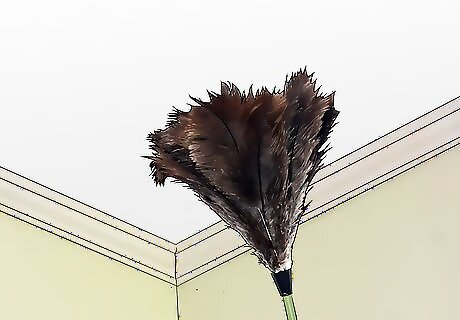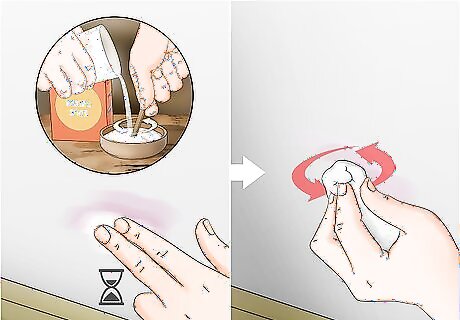
views
Removing Debris

Vacuum the ceiling. Simply take the vacuum and gently run it along the surface of the ceiling. Depending on the type of vacuum you have, you may be able to vacuum a substantial amount of debris before doing anything else. Use a bristle-brush attachment or another attachment intended for easily-scratched surfaces. Extend the telescoping shaft of your vacuum, if you have one. Pay special attention to corners, where crown molding meets the ceiling, and areas around air vents.

Use a duster. Take your duster and dust back-and-forth across the entire surface of the ceiling. Make sure to get as much dust and debris off the ceiling as you can. You may need to clean or dust your duster if the ceiling is exceptionally dirty. It might help if you vacuum the duster a couple of times while cleaning the ceiling. A microfiber attachment on your duster will pick up more dust and is less likely to scratch your ceiling.

Wipe dirty areas with a dry microfiber cloth. If certain parts of your ceiling are exceptionally dirty, you may need to use a dry microfiber cloth to wipe them. Take your cloth and gently pat or wipe the area. Avoid applying too much pressure so as not to rub dirt or dust into the ceiling. Get a new cloth once the one you are using is dirty. If you can't reach the ceiling, use a chair, ladder, or take a broom and fix your microfiber cloth to the end of it.
Wiping Down Your Ceiling

Create a cleaning mixture. While a variety of cleaning solutions will help clean your ceiling, you should create a specific solution that won’t damage paint, tiles, trim, and other surfaces. To create a cleaning solution: Mix 1 cup of warm water, 1 teaspoon of non-abrasive dish liquid (like Dawn), and 2 tablespoons of white vinegar. Pour the mixture into a spray bottle. Shake the spray bottle vigorously. Try to use organic cleaners rather than harsh chemicals.

Spray the ceiling. Take the spray bottle and spritz down the ceiling. Make sure to get somewhat complete coverage as you’ll be able to notice splotch marks on your ceiling if you don’t. Avoid soaking the surface of the ceiling. If the solution starts to drip down, you’ve probably sprayed too much.

Use a paint roller to roll over your ceiling. Find a large paint roller, dampen it with water, and roll allover your ceiling. Do so in a systematic way so that you get complete coverage of the ceiling. If you have a textured ceiling, try a dabbing motion instead of a wiping motion. Make sure you remove all the vinegar and detergent solution that you sprayed on the ceiling.

Pat the ceiling dry. After you’ve used a roller on the ceiling, take a clean cloth and gently pat the ceiling dry. The cloth will absorb any residual water and cleaning solution. Make sure the ceiling is clean before you dry it. If it is not, you may spread dirt and further dirty the ceiling. If you have trouble reaching the ceiling, get a long-handled painting roller or fix your roller to the shaft of a broom.
Cleaning Specific Stains

Use an eraser to remove pencil marks. If you have pencil marks or similar marks on your ceiling, you may be able to use an eraser to remove them. Simply take the eraser and gently rub it against the marks on your ceiling. An eraser will work best on pencil marks and may even work on crayon or pen marks. Use a large eraser so you can more easily remove large stains.

Try baking soda to remove stains. As with stains elsewhere, baking soda is very helpful in removing stains from ceilings. Create a paste and spread it over stains on the ceiling. Combine 2 tablespoons of baking soda with 2 tablespoons of water and mix thoroughly. Allow the paste to sit on the stain for a few minutes. Wipe the paste in a circular motion.

Apply trisodium phosphate (TSP) to soot stains. Purchase TSP at a home improvement store and mix some with a small amount of water. This should create a thick paste. Use a painting brush to apply the paste to the stained area. Only use as much as you need to cover the stain. Follow the manufacturer’s directions printed on the TSP container. Use goggles or other safety equipment. Place a plastic sheet or cardboard box beneath the stain so the TSP doesn’t damage your flooring.



















Comments
0 comment